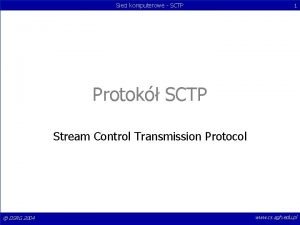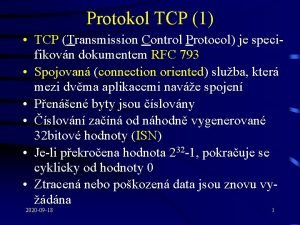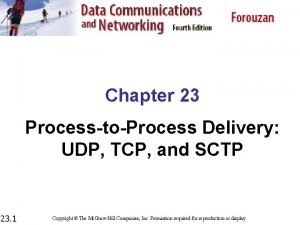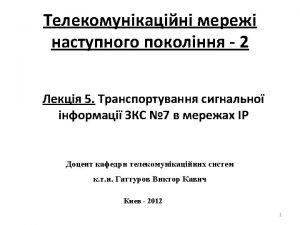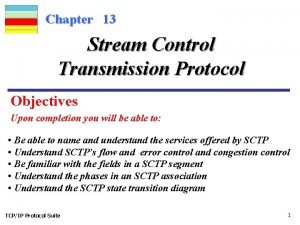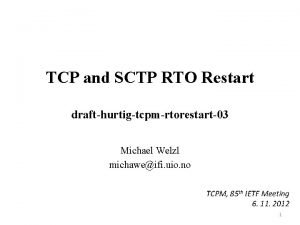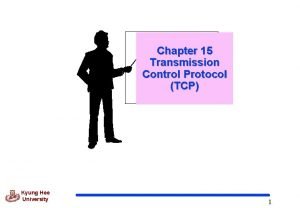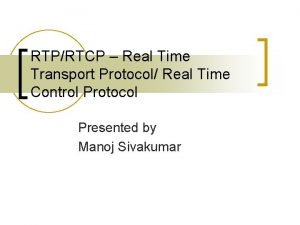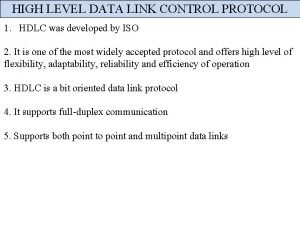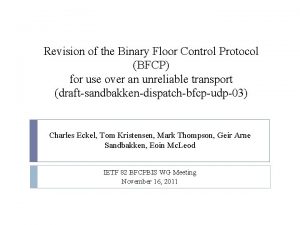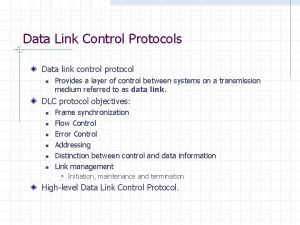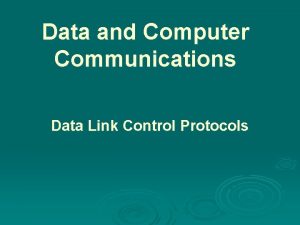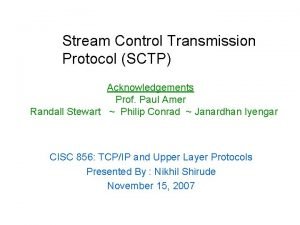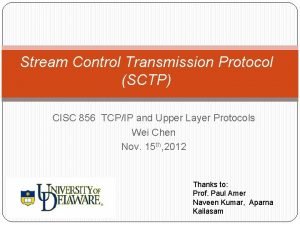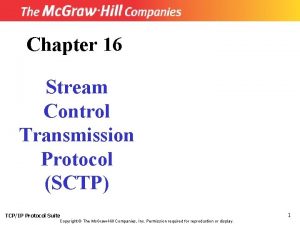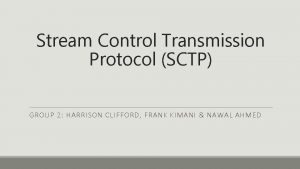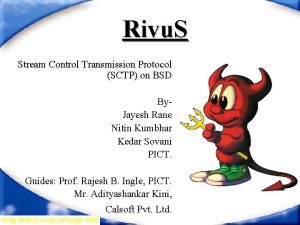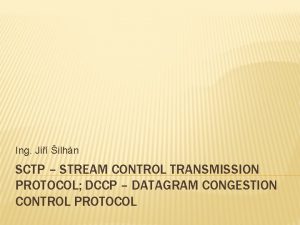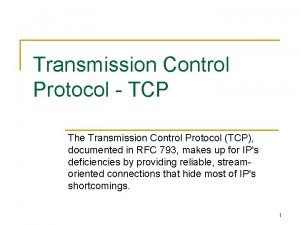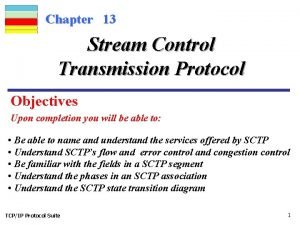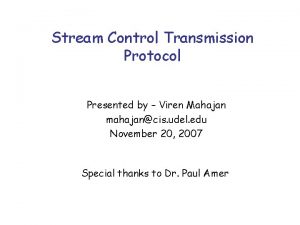Performance of SCTP Stream Control Transmission Protocol Student

































- Slides: 33

Performance of SCTP (Stream Control Transmission Protocol) Student: Elvis Pfützenreuter Advisor: Prof. Luis Fernando Friedrich, Ph. D

Why do we need another transport protocol? ● TCP: reliable stream of bytes ● UDP: unreliable datagrams ● No reliable atomic message transmission ● No variable degrees of reliability (only all or nothing) ● Several channels or streams in one connection TCP UDP IP / IPv 6 Link layer ? ? ?

SCTP history ● ● ● SIGTRAN comittee wanted a transport protocol for SS 7 MDTP (Multinetwork Datagram Transmission Protocol): did what SIGTRAN wanted, but it ran over UDP MDTP evolved until becoming SCTP that is a transport protocol MDTP SCTP UDP SCTP IP / IPv 6

Associations and streams ● ● ● SCTP association: analogous to TCP conn. Streams: unidirectional channels for message transmission (up to 2^16 per direction) Number of streams negotiated at connection initiation Streams Terminal

Atomic messages ● ● Sent and received atomically (always at once) Can be bigger than a datagram (if implementation allows) Application may ignore message boundaries Delivery order is obeyed only within each stream (avoids HOL Blocking) Msg #4 Msg #3 Msg #2 Msg #1 Fluxos Msg #3 Wait msg#1 retransmission Msg #2 Msg #1 lost

Partial reliability ● “urgent” messages ● Messages with time to live (deadline) ● What about unreliable messages? ● ● PR-SCTP (Partial Reliability SCTP) extension: redefines time to live All types may go through the same stream Msg #3 Waits #1 retransm. Msg #2 urgent Delivered as soon as it arrives Msg #1 lost

Multihomed associations ● Multihomed computer: connected to a TCP/IP internetwork by two or more ways ● SCTP offers automatic fail-over in this case ● Rivu. S extension also allows load balancing ● Terminal Inexpensive network redundancy without having to be an AS (Autonomous System) Inter-rede (e. g. Internet) Terminal

More SCTP details ● No half-open state, immune to blind spoof and SYN flood ● Checksum is 32 bits (CRC 32 c) ● Congestion control exactly like TCP ● Architecture of TLV structures instead of bitmaps ● API BSD Sockets: TCP and UDP style Type (8 b) Flags (8 b) Length (16 b) Value Valule – 32 -bit aligned

Work objectives Find oportunities of using SCTP in place of TCP or UDP in preexisting application protocols Performance tests: raw data and with application protocols (HTTP, SMB, RTP) Offer examples of SCTP API Sockets usage Feedback to LK-SCTP maintainers

• SCTP use cases ● In place of TCP ● ● ● Atomic messages Multiple connections belonging to a single transaction Better security Multipath In place of UDP ● ● SCTP has no broad/multicast! Some real-time multimedia apps.

• ● ● Performance SCTP x TCP Implementations: SCTP and TCP present in standard Linux 2. 6. 9 Test validity issues Latency and throughput tests with reliable messages TCPM and UNIXM: application protocols for simple message separation in TCP e UNIX Tests applied in these points TCPM TCP IP / IPv 6 SCTP TCPM application proto Byte 0 x. EE Payload byte 0 x. FF

• Loopback - throughput ● ● Message size is varied TCP: performance well over SCTP (9 x to 4 x). Causes: ● ● ● ● CRC-32 c (is NOT the bottleneck) Message separation Memory-to-memory data copies Context switches Unfair comparison TLV overhead TCPM: throughput about the same as UNIXM and SCTP

• Loopback – latency ● ● ● Message size is varied Latency SCTP 2 x worse than TCPM Serialization of all latencies Library lksctp-tools deemed NOT guilty SCTP extra latency is inside the kernel

• 100 Mbps ● ● Message size is varied SCTP throughput below TCP and TCPM (even 10 x less for 10 -byte message) ● Problems with SCTP Chunk bundling ● Difference gets narrower as the message size increases (1000 bytes or more) SCTP latency 25% bigger than TCPM ● All next texts use 500 -byte messages ●

• ● ● ● 100 Mbps, loss 0% to 10% SCTP throughput better than TCPM for network losses >1% SACK of SCTP worked well, but. . . SCTP latency was bad for losses >1% ● ● Minimum and initial RTOs set default too high (1000 ms) but can be tuned TCP-inherited congestion control Tuned RTOs deliver same performance as TCP Still needs more tests

10 Mbps latency from 5 ms to 300 ms • ● ● SCTP throughput 15% less than TCPM Throughput of both protocols fall and difference narrows as network latency increases ● ● Cause: untuned reception buffer TCPM latency equals SCTP (both follow RTT = inherent net latenc)

10 Mbps latency 5 ms to 300 ms loss 1% • ● ● ● SCTP throughput 27% less SCTP latency 2 x more than TCP Both differences to TCP narrow as the network latency increases ● ● Reception buffer not tuned Default minimum RTO too high

• 1 Mbps net latency 50 ms ● ● ● Net latency 50 ms +/- 25 ms with 50% correlation 1% packet duplication Variable losses because of shaping 1 Mbps No constant losses SCTP throughput 8% less Latency SCTP 9% more ● ● Default Minimum RTO too high Constant loss of 0, 1%: no change

• 11 Mbps wireless ad-hoc ● Path with 2 segments ● ● Total throughput: 3 Mbps ● ● ● 802. 11 e Ethernet Wifi signal quality was bad, on purpose SCTP throughput 25% less SCTP latency 22% more

• Two clients 100 Mbps ● ● “Strong” clients against “weak” (slow) server Throughput: SCTP shared it equally by all clients and directions ● ● TCP had problems, summed throughput was smaller Latency with 2 clients ● ● Increased 30% with SCTP, from 1 -client latency. Increased only 15% in TCPM Cause: SCTP overhead in slow server

• Multipath 10/11 Mbps ● ● ● Tests if it works, not the performance Primary path enabled/blocked every 10 seconds SCTP needed some tuning to work properly ● path_max_retrans lowered from 5 to 1

• Conclusions at this point ● SCTP performance “worse” than TCP, TCP still has the best raw throughput ● ● SCTP migration only if other good reasons can be found CRC-32 c influence in latency less than expected Minimum and default RTOs of 1000 ms (too high) Congestion control not suitable for constant loss channels

• HTTP tests ● ● Softwares: thttpd and httperf Adaptation of HTTP to SCTP, using a pair of streams per file ● ● Inspired from SSL adaptation to SCTP Using several SCTP streams incresases performance ● ● Small open/close connection overhead Less HOL blocking



• SMB tests ● ● ● Softwares: Samba and smbclient Simple replacement of TCP by SCTP Performance increase was expected Reality check: SCTP performance was (not much) below TCP, much like the raw performance tests More elaborated software adaptation would be necessary to explore SCTP to its full potential

• ● ● RTP tests Software: POC version 0. 3. 7 MP 3 over UDP RFC 2250, RFC 3119, FEC Partial reliability SCTP ● ● Unordered delivery, finite time to live PR—SCTP increased resistance against network problems Partial reliability demand application changes for full potential




• Other tests published ● KANG & FIELDS (2003) ● ● RAJAMANI et al. (2002) ● ● ● Usage of several streams to increase throughput, much like our HTTP test KAME/BSD implementation HTTP Overall results agree with ours Out of order (“urgent”) messages to increase throughput KANG & FIELDS ideas can not be used for preexisting applicaiton protocols based on TCP

• Conclusions ● ● ● SCTP delivers its promises Near production quality No showstopper problem in LK-SCTP Is not a silver bullet All detected problems are solvable in single time Consistent advantages of using SCTP as transport for (HTTP, RTP)

THE EN D •
 Sctp
Sctp Flow control in sctp is similar to that in
Flow control in sctp is similar to that in Transmission control protocol
Transmission control protocol Tcp (transmission control protocol) to protokół
Tcp (transmission control protocol) to protokół Transmission control protocol
Transmission control protocol Differentiate byte stream and character stream
Differentiate byte stream and character stream Tcp and sctp are both layer protocols
Tcp and sctp are both layer protocols Sctp sigtran
Sctp sigtran 13stream
13stream Sctp rto
Sctp rto Protocolo sctp
Protocolo sctp Transmission control block
Transmission control block Through course tasks
Through course tasks Looking at student work
Looking at student work The variable for fbd control parameters includes
The variable for fbd control parameters includes Witness tube as sterilization monitor
Witness tube as sterilization monitor Performance qualification protocol
Performance qualification protocol What is skinny client control protocol
What is skinny client control protocol Real time control protocol
Real time control protocol Domain host control protocol
Domain host control protocol High level data link control
High level data link control Binary floor control protocol
Binary floor control protocol Real time control protocol
Real time control protocol The ppp link control protocol was terminated
The ppp link control protocol was terminated Hdlc adalah
Hdlc adalah High level data link control protocol
High level data link control protocol Which protocol has neither flow nor error control
Which protocol has neither flow nor error control Hdlc operation
Hdlc operation How's your last weekend
How's your last weekend We ...... a big piece of wood last saturday. (see)
We ...... a big piece of wood last saturday. (see) National clearinghouse student tracker
National clearinghouse student tracker Class maths student student1 class student string name
Class maths student student1 class student string name National student clearinghouse student tracker
National student clearinghouse student tracker Student freckle. com
Student freckle. com
